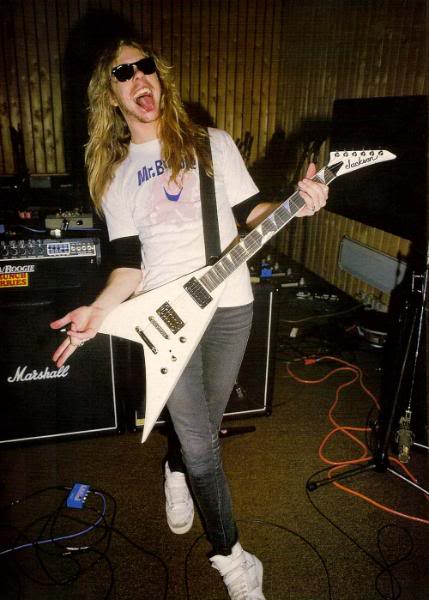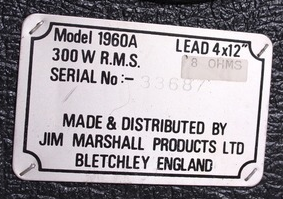Hello fellow Metallica fans,
I stumbled across this board topic when I was researching Marshall cabinet serial numbers - indeed, the Boogie Board features better information on this than what can be found anywhere else on the web

I think that I can contribute even more confusion to the topic of speakers of Metallica and MoP, but hopefully I will also be able to clear some things up and maybe you'll like my theory and thoughts on this.
A short preamble: Celestion speakers, even today, come in different versions, even if their "name" is the same. This has always been the case, even with the famous Greenbacks. Basically, there are several speakers that are called G12H or G12M. The G does not stand for "guitar", it was used to denote a "general" purpose speaker. That is why you can find "guitar" and "bass" speakers, but also PA and full-range speakers that have the same label. I use the term "guitar" and "bass" because that is what they are usually being referred to, even though there is no actual statement on this from Celestion. I think that the term actually comes from Marshall, because they put "bass" stickers on their "1982" cabinets where the "bass" version could usually be found.
The G12-65 (and its big brother G12-80 and also its smaller twins...) also came in different versions, from guitar to bass, to PA versions with smooth cones and twin-cone full range attempts. I would like to focus on two versions that were used by Marshall.
T3053/T3054/T3120 aka "lead": These are the typical G12-65 speakers of the late 70ies/early 80ies, they all feature the 1777 "lead" cone. T3053 is the 8 ohm version, T3054 is 15 ohm and T3120 is the Marshall labeled 15 ohm version. Lead refers to the higher resonance frequency of the 1777 cone. In a nutshell, this speaker has more mids than the "bass" version of the G12-65.
T3101/(and others?) aka "bass": These are also G12-65 speakers, but they feature the lower resonance 444 cone. T3101 has a Marshall label! Generally, these speakers would have been preferred to be used with bass guitars and they do not have the best reputation. I don't know where, but I have read (several times!) in different guitar boards and on blog posts, that they are unusable with guitars... but as a matter of fact Marshall also put them in guitar cabinets. I also think that they sound fantastic. They could be found in the 2x12 1936 cabinets and sometimes in the 1960B cabinets.
In my opinion there is almost no consistency on which speakers were used. As a general rule for the very early 80ies:
- 1960A G12-65 1777 cone
- 1960A G12-65 1777 cone
- 1960B G12-65 1777 or 444 cone <--- this is important
- 1982A G12-80 1777 cone
- 1982B G12-80 444 cone
But there were also the 1935 cabinets, they are not that common (but I will come back to them later...):
- 1935A G12-65 444 cone
- 1935B G12-65 444 cone
Usually another G12-65 would only cause more confusion, but with the G12-65 it is different. Early T3101 versions look very different, because they feature an oversized dust cap that is distinctively larger than the dust cap the G12-65 lead speakers.
On the left you see a 1978 T3054 Celestion label G12-65, right is a 1980 Marshall label T3101, I took that picture a few weeks ago when I changed some speakers.
Why does all of this matter? Because in my opinion Hetfield probably did not use the G12-65 that everybody thinks he did. All the following is a bit speculative, but I will try to explain my reasoning.
I think that the G12-65 that Hetfield had was one with a bass/444 cone.
Try to take a look at the dust cap of the speakers in his cabinet. To me, it looks bigger than that of the lead speaker and more like that of the right one.
What is the real bummer, though? It is the fact that 300W sticker cabs with G12-65 exist! You can find 1935 cabinets from 1985 (!) with G12-65 speakers. These speakers are the T3101 bass version G12-65, but by 1985 they did not have the Marshall label anymore and instead feature a white-label that has the same bold font as the G12T-75. Take a look at this:
https://www.vintageandrare.com/product/Marshall-JCM800-1935A-CELESTION-G12-65-1985-68465
300W sticker, G12-65, T3101 with bass cone in a package that looks very much like your standard Marshall 1960.
Does all of this make sense? I think it does. I have many different Celestions: G12-80, with both 444 and 1777 cone, the already shown G12-65 with 1777 and 444 cones, mid 80ies G12T-75 (not vented anymore...), G12M/H Greenbacks and G12M Blackbacks. I do not have a Boogie, but I can get really close with the G12-65 and G12-80, but the closest to the MoP sound is the T3101 bass version G12-65. The G12T-75 on the other hand is not even there. They sound like AJFA and Seattle 89, not like MoP. I can easily switch between those sounds, but not by tweaking the amp. I have to change the cabinet. My theory also explains why the "normal" G12-65 does not get you there 100% and it explains the 300W note.
Let us also not forget that we are talking about the 80ies. Hetfields tone was very bassy for that time and they tried to get it tight. That is why it makes so much sense to use a bass oriented speaker in this case.

















